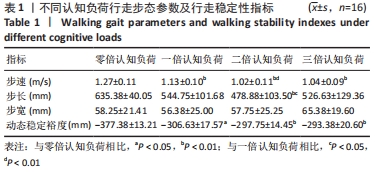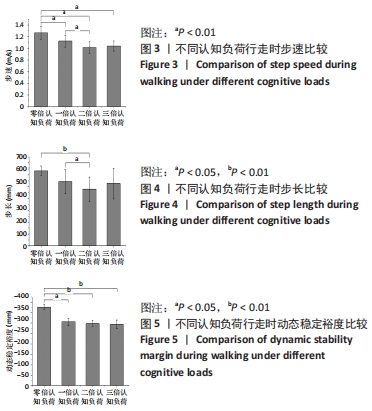[1] SMALL GH, BROUGH LG, NEPTUNE RR. The influence of cognitive load on balance control during steady-state walking. J Biomech. 2021; 122:110466.
[2] TIMMERMANS C, ROERDINK M, JANSSEN T, et al. Dual-Task Walking in Challenging Environments in People with Stroke: Cognitive-Motor Interference and Task Prioritization. Stroke Res Treat. 2018; 2018:7928597.
[3] FREIRE JR, PORTO JM, MARQUES NR, et al. The effects of a simultaneous cognitive or motor task on the kinematics of walking in older fallers and non-fallers. Hum Mov Sci. 2017;51:146-152.
[4] BEURSKENS R, BOCK O. Age-related deficits of dual-task walking: a review. Neural Plast. 2012;2012:131608.
[5] AL-YAHYA E, DAWES H, SMITH L, et al. Cognitive motor interference while walking: a systematic review and meta-analysis. Neurosci Biobehav Rev. 2011;35(3):715-728.
[6] BAETENS T, DE KEGEL A, PALMANS T, et al. Gait analysis with cognitive-motor dual tasks to distinguish fallers from nonfallers among rehabilitating stroke patients. Arch Phys Med Rehabil. 2013;94(4):680-686.
[7] HYNDMAN D, ASHBURN A, YARDLEY L, et al. Interference between balance, gait and cognitive task performance among people with stroke living in the community. Disabil Rehabil. 2006;28(13-14):849-856.
[8] RILEY MA, BAKER AA, SCHMIT JM, et al. Effects of visual and auditory short-term memory tasks on the spatiotemporal dynamics and variability of postural sway. J Mot Behav. 2005;37(4): 311-324.
[9] 朱婷, 安丙辰, 梁贞文, 等. 认知对姿势控制能力影响的研究进展[J]. 中华老年病研究电子杂志,2015,2(1):35-38.
[10] SWAN L, OTANI H, LOUBERT PV. Reducing postural sway by manipulating the difficulty levels of a cognitive task and a balance task. Gait Posture. 2007;26(3):470-474.
[11] MADEHKHAKSAR F, EGGES A. Effect of dual task type on gait and dynamic stability during stair negotiation at different inclinations. Gait Posture. 2015;9(9):4566-4571.
[12] MORIOKA S, HIYAMIZU M, YAGI F. The effects of an attentional demand tasks on standing posture control. J Physiol Anthropol Appl Human Sci. 2005;24(3):215-219.
[13] ZHANG C, SONG Q, SUN W, et al. Dynamic stability of older adults under dual task paradigm during stair descent. Motor Control. 2020; 24(1):113-126.
[14] 梁雷超, 黄灵燕, 伍勰, 等. 膝骨关节炎对女性老年人步行动态稳定性的影响[J]. 体育科学,2016,36(3):61-66.
[15] 王疆娜, 郑慧芬, 孙威. 下楼梯行走执行手机任务时下肢动态稳定性、运动协调性及关节力学的变化[J]. 中国组织工程研究, 2021,25(6):837-843.
[16] MEESTER D, AL-YAHYA E, DENNIS A, et al. A randomized controlled trial of a walking training with simultaneous cognitive demand (dual-task) in chronic stroke. Eur J Neurol. 2019;26(3):435-441.
[17] Tramontano M, Morone G, Curcio A, et al. Maintaining gait stability during dual walking task: effects of age and neurological disorders. Eur J Phys Rehabil Med. 2017;53(1):7-13.
[18] SIMONI D, RUBBIERI G, BACCINI M, et al. Different motor tasks impact differently on cognitive performance of older persons during dual task tests. Clin Biomech (Bristol,Avon). 2013;28(6):692-696.
[19] KELLY VE,JANKE AA,SHUMWAY-COOK A. Effects of instructed focus and task difficulty on concurrent walking and cogni- tive task performance in healthy young adults. Exp Brain Res. 2010;207(1/2):65-73.
[20] YOGEV-SELIGMANN G,HAUSDORFF JM,GILADI N. The role of executive function and attention in gait. Mov Disord. 2008;23(3):329-342.
[21] REGNAUX JP, ROBERSTON J, SMAIL DB, et al. Human treadmillwalking needs attention. J Neuroeng Rehabil. 2006;3:19.
[22] PLUMMER-D’AMATO P, ALTMANN LJ, SARACINO D, et al. Interactions between cognitive tasks and gait after stroke: a dual task study. Gait Posture. 2008;27:683-688.
[23] EIMER M. Crossmodal links in spatial attention between vision, audi- tion, and touch: evidence from event-related brain potentials. Neuropsychologia. 2001;39:1292-1303.
[24] 黄彩平, 谢欲晓, 王思远, 等. 步行-执行功能双任务训练对慢性脑卒中患者康复的研究进展[J]. 中国康复医学杂志,2018,33(8):988-992.
[25] 刘立,张庭然,罗炯,等.老年人与年轻人双重任务下阶梯行走步态特征比较[J]. 中国康复理论与实践,2020,26(3):285-290.
[26] SOANGRA R, LOCKHART TE. Dual-Task Does Not Increase Slip and Fall Risk in Healthy Young and Older Adults dur- ing Walking. Appl Bionics Biomech. 2017;(2017):1014784.
[27] 杨凤娇,王芗斌,侯美金,等. 三维步态分析比较青年人与老年人双任务下步态特征的差异[J]. 中国组织工程研究,2021,25(3):344-349.
[28] 郑慧芬,孙威,宋祺鹏,等.手机任务介入对下楼梯行走动态稳定性的影响[J]. 中国运动医学杂志,2021,40(7):528-535.
[29] REMAUD A, BOYAS S, CARON GAR, et al. Attentional demands associated with postural control depend on task difficulty and visual condition. J Mot Behav. 2012;44(5):329-340.
[30] GHAI S, GHAI I, EFFENBERG AO. Effects of dual tasks and dual-task training on postural stability: a systematic review and meta-analysis. Clin Interv Aging. 2017;12:557-577.
[31] WULF G, WEIGELT M, POULTER D, et al. Attentional focus on suprapostu ral tasks affects balance learning.Q J Exp Psychol A. 2003;56(7):1191-1211.
[32] 刘丹, 陆阿明. 双重认知任务介入对人体静态稳定性的影响[J]. 湖北体育科技,2019,38(10):903-909.
[33] LACOUR M, BERNARD-DEMANZE L, DUMITRESCU M. Posture control, aging, and attention resources: models and posture-analysis methods. Neurophysiol Clin. 2008;38(6):411-421.
|







